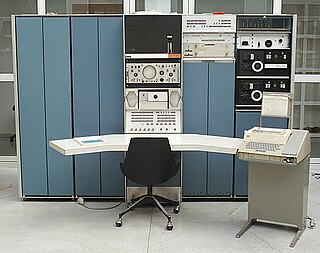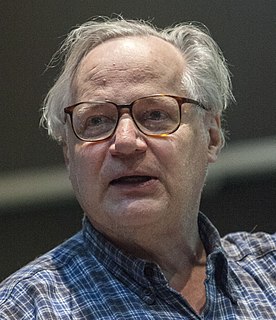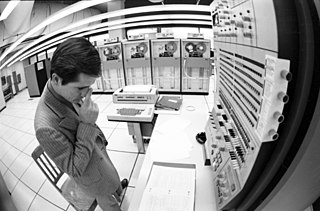Related Research Articles
In computing, a compiler is a computer program that translates computer code written in one programming language into another language. The name "compiler" is primarily used for programs that translate source code from a high-level programming language to a lower level language to create an executable program.

Lisp is a family of programming languages with a long history and a distinctive, fully parenthesized prefix notation. Originally specified in 1958, Lisp is the second-oldest high-level programming language still in common use. Only Fortran is older, by one year. Lisp has changed since its early days, and many dialects have existed over its history. Today, the best-known general-purpose Lisp dialects are Racket, Common Lisp, Scheme, and Clojure.

Lisp machines are general-purpose computers designed to efficiently run Lisp as their main software and programming language, usually via hardware support. They are an example of a high-level language computer architecture, and in a sense, they were the first commercial single-user workstations. Despite being modest in number Lisp machines commercially pioneered many now-commonplace technologies, including effective garbage collection, laser printing, windowing systems, computer mice, high-resolution bit-mapped raster graphics, computer graphic rendering, and networking innovations such as Chaosnet. Several firms built and sold Lisp machines in the 1980s: Symbolics, Lisp Machines Incorporated, Texas Instruments, and Xerox. The operating systems were written in Lisp Machine Lisp, Interlisp (Xerox), and later partly in Common Lisp.
PL/I is a procedural, imperative computer programming language developed and published by IBM. It is designed for scientific, engineering, business and system programming. It has been used by academic, commercial and industrial organizations since it was introduced in the 1960s, and is still used.

The PDP-7 was a minicomputer produced by Digital Equipment Corporation as part of the PDP series. Introduced in 1964, shipped since 1965, it was the first to use their Flip-Chip technology. With a cost of US$72,000, it was cheap but powerful by the standards of the time. The PDP-7 is the third of Digital's 18-bit machines, with essentially the same instruction set architecture as the PDP-4 and the PDP-9.
Incompatible Timesharing System (ITS) is a time-sharing operating system developed principally by the MIT Artificial Intelligence Laboratory, with help from Project MAC. The name is the jocular complement of the MIT Compatible Time-Sharing System (CTSS).
Macsyma is one of the oldest general-purpose computer algebra systems still in wide use. It was originally developed from 1968 to 1982 at MIT's Project MAC.
Interlisp is a programming environment built around a version of the programming language Lisp. Interlisp development began in 1966 at Bolt, Beranek and Newman in Cambridge, Massachusetts with Lisp implemented for the Digital Equipment Corporation (DEC) PDP-1 computer by Danny Bobrow and D. L. Murphy. In 1970, Alice K. Hartley implemented BBN LISP, which ran on PDP-10 machines running the operating system TENEX. In 1973, when Danny Bobrow, Warren Teitelman and Ronald Kaplan moved from BBN to the Xerox Palo Alto Research Center (PARC), it was renamed Interlisp. Interlisp became a popular Lisp development tool for artificial intelligence (AI) researchers at Stanford University and elsewhere in the community of the Defense Advanced Research Projects Agency (DARPA). Interlisp was notable for integrating interactive development tools into an integrated development environment (IDE), such as a debugger, an automatic correction tool for simple errors (via do what I mean software design, and analysis tools.

MIT Computer Science and Artificial Intelligence Laboratory (CSAIL) is a research institute at the Massachusetts Institute of Technology (MIT) formed by the 2003 merger of the Laboratory for Computer Science (LCS) and the Artificial Intelligence Laboratory. Housed within the Ray and Maria Stata Center, CSAIL is the largest on-campus laboratory as measured by research scope and membership. It is part of the Schwarzman College of Computing but is also overseen by the MIT Vice President of Research.

Richard D. Greenblatt is an American computer programmer. Along with Bill Gosper, he may be considered to have founded the hacker community, and holds a place of distinction in the communities of the programming language Lisp and of the Massachusetts Institute of Technology (MIT) Artificial Intelligence Laboratory.
TOPS-10 System is a discontinued operating system from Digital Equipment Corporation (DEC) for the PDP-10 mainframe computer family. Launched in 1967, TOPS-10 evolved from the earlier "Monitor" software for the PDP-6 and PDP-10 computers; this was renamed to TOPS-10 in 1970.

In computer programming, Franz Lisp is a discontinued Lisp programming language system written at the University of California, Berkeley by Professor Richard Fateman and several students, based largely on Maclisp and distributed with the Berkeley Software Distribution (BSD) for the Digital Equipment Corporation (DEC) VAX minicomputer. Piggybacking on the popularity of the BSD package, Franz Lisp was probably the most widely distributed and used Lisp system of the 1970s and 1980s.
New Implementation of LISP (NIL) is a programming language, a dialect of the language Lisp, developed at the Massachusetts Institute of Technology (MIT) during the 1970s, and intended to be the successor to the language Maclisp. It is a 32-bit implementation, and was in part a response to Digital Equipment Corporation's (DEC) VAX computer. The project was headed by Jon L White, with a stated goal of maintaining compatibility with MacLisp while fixing many of its problems.
Bernard S. Greenberg is a programmer and computer scientist, known for his work on Multics and the Lisp machine.

Emacs or EMACS is a family of text editors that are characterized by their extensibility. The manual for the most widely used variant, GNU Emacs, describes it as "the extensible, customizable, self-documenting, real-time display editor". Development of the first Emacs began in the mid-1970s, and work on its direct descendant, GNU Emacs, continues actively as of 2022.

In computing, a compiler is a computer program that transforms source code written in a programming language or computer language, into another computer language. The most common reason for transforming source code is to create an executable program.
The history of the programming language Scheme begins with the development of earlier members of the Lisp family of languages during the second half of the twentieth century. During the design and development period of Scheme, language designers Guy L. Steele and Gerald Jay Sussman released an influential series of Massachusetts Institute of Technology (MIT) AI Memos known as the Lambda Papers (1975–1980). This resulted in the growth of popularity in the language and the era of standardization from 1990 onward. Much of the history of Scheme has been documented by the developers themselves.

David A. Moon is a programmer and computer scientist, known for his work on the Lisp programming language, as co-author of the Emacs text editor, as the inventor of ephemeral garbage collection, and as one of the designers of the Dylan programming language. Guy L. Steele Jr. and Richard P. Gabriel (1993) name him as a leader of the Common Lisp movement and describe him as "a seductively powerful thinker, quiet and often insulting, whose arguments are almost impossible to refute".
In a computer instruction set architecture (ISA), an execute instruction is a machine language instruction which treats data as a machine instruction and executes it.
References
- 1 2 Levy, Steven (1984). Hackers: Heroes of the Computer Revolution . Doubleday. ISBN 0-385-19195-2.
- ↑ Project MAC Progress Report IV: July 1966 to July 1967 (PDF) (Report). n.d. p. 19. Archived from the original (PDF) on March 8, 2016.
The higher-level language used for most of the vision laboratory program is the PDP-6 LISP System. This system is based chiefly on the LISP 1.5 programming language, but has been extensively modified in a number of ways. These include many new functions and services, including facilities for linking with programs written in other languages.
- ↑ Moon 1974 , p. 1
- ↑ Moon 1974 , p. 47
- ↑ Lisp 1.5 p. 13, evaluating an atom
ein the environmentais done with(cdr (assoc e a)). That involves a linear search of the association lista. A more involved description with global constants and errors is given on p. 71; it does a linear search of the property list before searching the association list. - ↑ Maclisp uses
defun; Lisp 1.5 usesdefine. - ↑ Moon 1974 , p. 107; the
autoloadproperty. - ↑ Pitman, Kent (December 16, 2007). "The Revised Maclisp Manual (The Pitmanual), Sunday Morning Edition". maclisp.info. HyperMeta, Inc. Declarations and the Compiler, Concept "Variables". Retrieved October 20, 2018.
If the variable to be bound has been declared to be special, the binding is compiled as code to imitate the way the interpreter binds variables.
- ↑ Pitman, Kent (December 16, 2007). "The Revised Maclisp Manual (The Pitmanual), Sunday Morning Edition". maclisp.info. HyperMeta Inc. p. 1 FAQ q1. Retrieved October 20, 2018.
Project MAC had nothing to do with the Apple "Mac". And neither did MACLISP.
